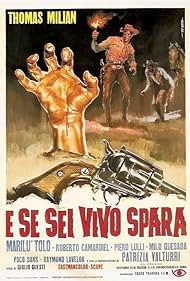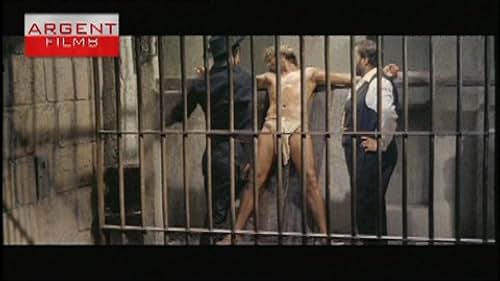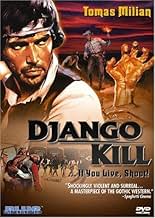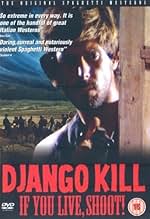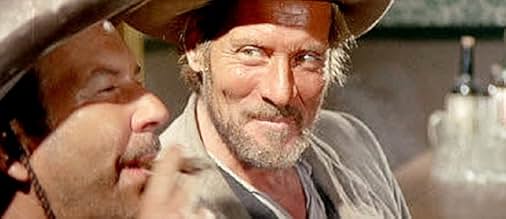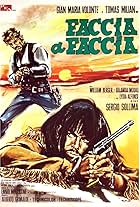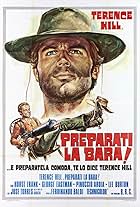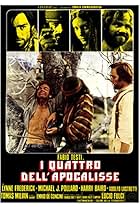VALUTAZIONE IMDb
6,3/10
3013
LA TUA VALUTAZIONE
Varie fazioni, tra cui un bandito mezzosangue, una banda di cowboy omosessuali e un prete, litigano per l'oro rubato in una città surreale.Varie fazioni, tra cui un bandito mezzosangue, una banda di cowboy omosessuali e un prete, litigano per l'oro rubato in una città surreale.Varie fazioni, tra cui un bandito mezzosangue, una banda di cowboy omosessuali e un prete, litigano per l'oro rubato in una città surreale.
Marilù Tolo
- Flory
- (as Marilu' Tolo)
Francisco Sanz
- Reverend Alderman
- (as Paco Sanz)
Ángel Silva
- Indian
- (as Angel Silva)
Sancho Gracia
- Willy
- (as Félix Sancho Gracia)
Mirella Pamphili
- Woman in Town
- (as Mirella Panfili)
Ray Lovelock
- Evan Templer
- (as Raymond Lovelock)
Calogero Azzaretto
- Pablo, Sorrow's Henchman
- (non citato nei titoli originali)
Lars Bloch
- Oaks Gang Member
- (non citato nei titoli originali)
Frank Braña
- Templer Henchman
- (non citato nei titoli originali)
Sisto Brunetti
- Sorrow's Henchman
- (non citato nei titoli originali)
Ann Collin
- Flory
- (voce (canto))
- (non citato nei titoli originali)
Gene Collins
- Collins
- (non citato nei titoli originali)
Trama
Lo sapevi?
- QuizAccording to the actors and director, the producers decided to release the movie in countries outside Italy as "Django, Kill!" as a way to take advantage of the success of a prior release, Django (1966) starring Franco Nero. In reality, "Django" had nothing to do with "Se sei Vivo Spara."
- BlooperDuring the lynching of Oaks' gang, the tire tracks of the camera car are clearly visible down the middle of the main street.
- Versioni alternativeThe Italian print includes a sequence where gold bullets are dug out of the still living character, Oaks. This was cut from most export prints.
- ConnessioniFeatured in The Spaghetti West (2005)
Recensione in evidenza
This one certainly lives up to its reputation as the most peculiar Spaghetti Western there is, a quality which makes it unique but not exactly entertaining (the pace is slow and the film somewhat protracted, if never less than fascinating)!
It features an atypical performance from lead Tomas Milian: usually the brash man of action with a humorous streak, here he's the cynical and mostly passive observer who even arrives late for the climax! Apart from the star, Marilu' Tolo and Ray Lovelock, the international cast - including several non-professionals - is unfamiliar but, as director Questi said in the exclusive Audio Commentary, their indelible faces were just what he needed for the film! By the way, in spite of the film's English title, it's not related to the 1966 DJANGO - and, in fact, Milian's character remains unnamed throughout - that spawned innumerable variations but only one direct sequel (made more than 20 years after the original)!
Here, we also find several elements of Gothic horror (Milian 'rising' from the dead, the 'mad woman' character borrowed from "Jane Eyre", the weird prison torture scene involving vampire bats and iguanas, the fiery climax in which the villain's face is covered with melted gold, etc.); besides, Tolo is made-up to look like Barbara Steele and the greedy townsfolk's gory groping into the body of a dying bandit riddled with golden bullets curiously anticipates the zombie films of George Romero! Actually, the film's graphic depiction of violence gave it a certain notoriety which further fueled its cult status; in fact, the bullet sequence and the scalping of an Indian were censored at the time but, curiously, got reinstated for the shortened 1975 re-issue under the name of ORO HONDO (which had been the film's working title)! There's even a scene in which a horse is saddled with a charge of dynamite and let loose among the villains (whereupon we see shots of its intestines and the body parts of the various victims strewn about!) - though, in all fairness, in A PROFESSIONAL GUN (1968) a man was also nonchalantly killed by a grenade in the mouth!!
Other unexpected elements in the film are its religious overtones (apart from Milian's crucifixion, the Indians who help him are mystics while the villainous Hagerman also serves pretty much as a bible-thumping preacher to the community) and the presence of black-clad gay cowboys as prototype Fascists (thankfully, we're spared their gang-rape of Lovelock - here in his film debut! - whose immediate reaction, naturally, is to shoot himself) led by a Spaniard (all dressed in white!) that goes by the name of Mr. Zorro(?!), and who shares a love-hate relationship throughout with a spirited parrot!!
The film also features a good score by Ivan Vandor and Techniscope photography by Franco Delli Colli (though the outdoor night scenes are way too dark!), and the locations - Questi was especially proud of his uncharacteristic white desert - are notable too. Franco Arcalli, an unusual combination of screenwriter and film editor, devises some 'trippy' montages throughout - which, therefore, adds psychedelia to an already eclectic mix of cinematic styles that distinguish this Spaghetti Western!
I opted to purchase the Italian DVD over Blue Underground's R1 edition due to the inclusion here of the afore-mentioned highly informative, full-length Audio Commentary featuring director Questi (who is very modest and actually attributes many of the film's bizarre touches to logical progressions of the narrative - which, needless to say, doesn't entirely convince the trio of moderators who accompany him throughout this engaging discussion!). However, with respect to the otherwise commendable Alan Young Pictures disc, one has to contend with a distracting layer change (in mid-sentence!), at least one other instance of audio drop-out and a baffling reversal, for one line of dialogue, to the English soundtrack (for the record, I watched the Italian-language version with the audio set in its original mono rendition; I tend to scoff at re-mixes of classic films)!!
It features an atypical performance from lead Tomas Milian: usually the brash man of action with a humorous streak, here he's the cynical and mostly passive observer who even arrives late for the climax! Apart from the star, Marilu' Tolo and Ray Lovelock, the international cast - including several non-professionals - is unfamiliar but, as director Questi said in the exclusive Audio Commentary, their indelible faces were just what he needed for the film! By the way, in spite of the film's English title, it's not related to the 1966 DJANGO - and, in fact, Milian's character remains unnamed throughout - that spawned innumerable variations but only one direct sequel (made more than 20 years after the original)!
Here, we also find several elements of Gothic horror (Milian 'rising' from the dead, the 'mad woman' character borrowed from "Jane Eyre", the weird prison torture scene involving vampire bats and iguanas, the fiery climax in which the villain's face is covered with melted gold, etc.); besides, Tolo is made-up to look like Barbara Steele and the greedy townsfolk's gory groping into the body of a dying bandit riddled with golden bullets curiously anticipates the zombie films of George Romero! Actually, the film's graphic depiction of violence gave it a certain notoriety which further fueled its cult status; in fact, the bullet sequence and the scalping of an Indian were censored at the time but, curiously, got reinstated for the shortened 1975 re-issue under the name of ORO HONDO (which had been the film's working title)! There's even a scene in which a horse is saddled with a charge of dynamite and let loose among the villains (whereupon we see shots of its intestines and the body parts of the various victims strewn about!) - though, in all fairness, in A PROFESSIONAL GUN (1968) a man was also nonchalantly killed by a grenade in the mouth!!
Other unexpected elements in the film are its religious overtones (apart from Milian's crucifixion, the Indians who help him are mystics while the villainous Hagerman also serves pretty much as a bible-thumping preacher to the community) and the presence of black-clad gay cowboys as prototype Fascists (thankfully, we're spared their gang-rape of Lovelock - here in his film debut! - whose immediate reaction, naturally, is to shoot himself) led by a Spaniard (all dressed in white!) that goes by the name of Mr. Zorro(?!), and who shares a love-hate relationship throughout with a spirited parrot!!
The film also features a good score by Ivan Vandor and Techniscope photography by Franco Delli Colli (though the outdoor night scenes are way too dark!), and the locations - Questi was especially proud of his uncharacteristic white desert - are notable too. Franco Arcalli, an unusual combination of screenwriter and film editor, devises some 'trippy' montages throughout - which, therefore, adds psychedelia to an already eclectic mix of cinematic styles that distinguish this Spaghetti Western!
I opted to purchase the Italian DVD over Blue Underground's R1 edition due to the inclusion here of the afore-mentioned highly informative, full-length Audio Commentary featuring director Questi (who is very modest and actually attributes many of the film's bizarre touches to logical progressions of the narrative - which, needless to say, doesn't entirely convince the trio of moderators who accompany him throughout this engaging discussion!). However, with respect to the otherwise commendable Alan Young Pictures disc, one has to contend with a distracting layer change (in mid-sentence!), at least one other instance of audio drop-out and a baffling reversal, for one line of dialogue, to the English soundtrack (for the record, I watched the Italian-language version with the audio set in its original mono rendition; I tend to scoff at re-mixes of classic films)!!
- Bunuel1976
- 23 ago 2006
- Permalink
I più visti
Accedi per valutare e creare un elenco di titoli salvati per ottenere consigli personalizzati
- How long is Django Kill... If You Live, Shoot!?Powered by Alexa
Dettagli
- Tempo di esecuzione1 ora 40 minuti
- Mix di suoni
- Proporzioni
- 2.35 : 1
Contribuisci a questa pagina
Suggerisci una modifica o aggiungi i contenuti mancanti

Divario superiore
By what name was Se sei vivo spara (1967) officially released in India in English?
Rispondi